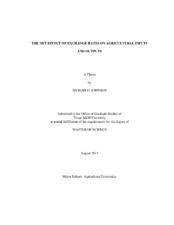| dc.description.abstract | For more than thirty years, studies about the effect of the exchange rate on exports have been conducted. However, few have considered the combined effect of the exchange rate on imported inputs into the agricultural system and the exports of final agricultural products those inputs produce. This work contributes to the agricultural economics literature by combining those effects. A current concern is for the net effect as the total value and quantity of inputs imported has increased. This research examines the effect of the exchange rate on imported inputs into the corn, wheat, and beef cattle production systems, breaking it down to a producer's budget, examining how the exchange rate affects profitability. Vector Autoregression (VAR) and Bayesian Averaging of Classical Estimates (BACE) models were estimated to evaluate the effects.
Daily and weekly price data were used for corn, wheat, feeder steers, ethanol, diesel, ammonia, urea, di-ammonium phosphate, and the exchange rate. A VAR model was estimated to model the relationship between the variables. After having incongruous test results in determining the lag length structure it was decided that a BACE model would be approximated. After estimating the BACE model, the price responses of the commodities to the exchange rates were estimated. The price responses were used in demonstrating the effect of the exchange rate on a producer's profitability.
It was determined that, generally, a strengthening exchange rate has a negative impact on prices. It was also found that the exchange rate has a greater impact on prices now than it did 14 years ago, implying that the exchange rate now has a greater affect on profitability. A one percent increase in the value of the dollar led to a decline in profitability ranging from $0.02/bu in wheat to $0.56/cwt in feeder steers. However, agricultural producers should not be overly concerned about a lower valued dollar from the perspective of their agricultural business. | en |


